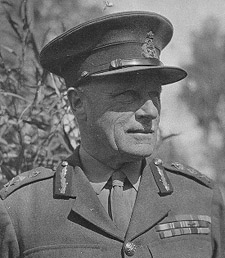
General Sir Edward Pellew Quinan was a British Army commander during the Second World War. In the early part of his career, he was involved in Indian Army campaigns in Afghanistan and Waziristan on the North West Frontier of the Indian Empire, in the days of the British Raj. During the First World War he served with the Indian Army forces in France and Mesopotamia, and was wounded. During the Second World War, Quinan commanded the British and Indian Army forces in the Anglo-Iraqi War, the Syria–Lebanon campaign, and the Anglo-Soviet invasion of Iran. He continued serving in the Middle East until 1943, when he returned to India to command the North West Army, but retired later the same year due to a downgrading of his fitness status.
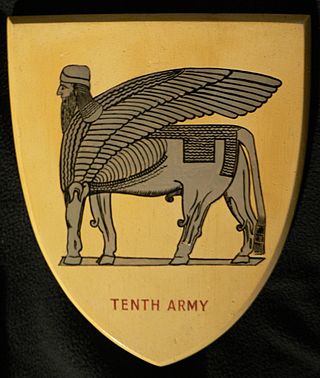
The Tenth Army was a field army of the British Army during the Second World War created in Iraq and formed from the major part of "Paiforce". It was active in 1942 and 1943, and then disbanded.

Middle East Command, later Middle East Land Forces, was a British Army Command established prior to the Second World War in Egypt. Its primary role was to command British land forces and co-ordinate with the relevant naval and air commands to defend British interests in the Middle East and eastern Mediterranean region.
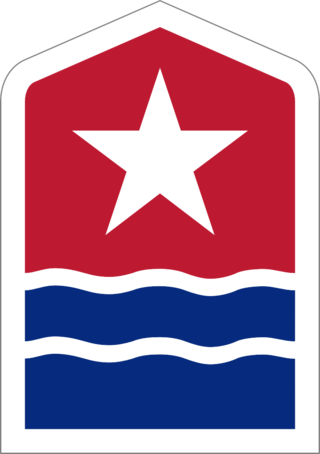
United States Army Forces in the Middle East(USAFIME) was a unified United States Army command during World War II established in August, 1942 by order of General George C. Marshall, the Chief of Staff of the United States Army, to oversee the Egypt-Libya campaign.
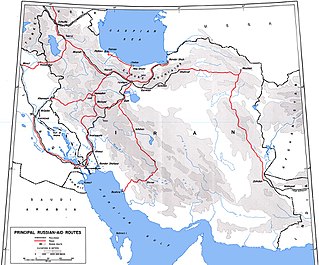
The Persian Corridor was a supply route through Iran into Soviet Azerbaijan by which British aid and American Lend-Lease supplies were transferred to the Soviet Union during World War II. Of the 17.5 million long tons of U.S. Lend-Lease aid provided to the Soviet Union, 7.9 million long tons (45%) were sent through Iran.
The military history of Iran has been relatively well-documented, with thousands of years' worth of recorded history. Largely credited to its historically unchanged geographical and geopolitical condition, the modern-day Islamic Republic of Iran has had a long and checkered military culture and history; ranging from triumphant and unchallenged ancient military supremacy, affording effective superpower status for its time; to a series of near-catastrophic defeats at the hands of previously subdued and conquered peripheral nations, most notably including the ancient Greek kingdom of Macedon as well as the Asiatic nomadic tribes at the northeastern boundary of the lands traditionally home to the Iranian peoples.
Project Cedar was a World War II project to deliver short-range aircraft from the United States to the USSR via Abadan, Iran in the Persian Gulf.

The Persia and Iraq Command was a command of the British Army established during the Second World War in September 1942 in Baghdad. Its primary role was to secure from land and air attack the oilfields and oil installations in Persia and Iraq. Its further role was to ensure the transport of supplies from Persian Gulf ports through Iraq and Persia to the Soviet Union.
A Sapper Army was a multi-brigade military construction engineer formation of the Engineer Troops of the Soviet Red Army during World War II. Formed to construct large-scale defensive works, sapper armies were used from late 1941 until mid-1942 when the Red Army opted to organize smaller and more flexible construction engineer formations. Although the organization of military construction engineers into an army-level echelon was unusual, the use of dedicated troops for military construction was common to many armies of World War II.

The United States Army Central, formerly the Third United States Army, commonly referred to as the Third Army and as ARCENT, is a military formation of the United States Army that saw service in World War I and World War II, in the 1991 Gulf War, and in the coalition occupation of Iraq. It is best known for its campaigns in World War II under the command of General George S. Patton.

The Anglo-Soviet invasion of Iran or Anglo-Soviet invasion of Persia was the joint invasion of the neutral Imperial State of Iran by the United Kingdom and the Soviet Union in August 1941. The invasion, code name Operation Countenance, was largely unopposed by the numerically and technologically outmatched Iranian forces. The multi-pronged coordinated invasion took place along Iran's borders with the Kingdom of Iraq, Azerbaijan SSR, and Turkmen SSR, with fighting beginning on 25 August and ending on 31 August when the Iranian government formally agreed to surrender, having already agreed to a ceasefire on 30 August.
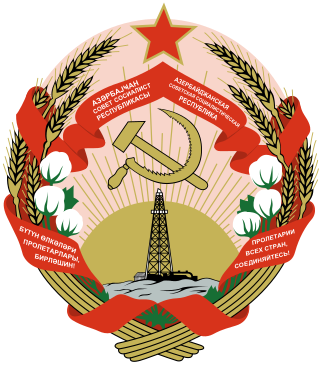
The Azerbaijan Soviet Socialist Republic entered World War II with the Soviet Union after the German declaration of war on June 22, 1941. Azerbaijan's oilfields were enticing to the Germans due to the USSR's heavy dependency on Caucasus oil – setting the scene for German campaigns attempting to capture and seize the oilfields in Baku during the Battle of the Caucasus. Azerbaijan’s oil was very decisive for Soviet victory. More than 600,000 people from Azerbaijan were conscripted to the Workers’ and Peasants’ Red Army during World War II from 1941 to 1945.
The 45th Army was a field army of the Red Army in World War II. Formed in late July 1941, the army spent most of the war guarding the Turkish border and disbanded in fall 1945.
The 9th Guards Motor Rifle Division was a Soviet Army unit initially formed as a tank corps in April 1942. In the same year, it was then formed as a mechanized corps in November 1942. This unit then became a Guards mechanized corps in September 1944. Following World War II, the corps were reorganized as a mechanized division in 1945 and then a motor rifle division in 1957 before being disbanded in 1958.
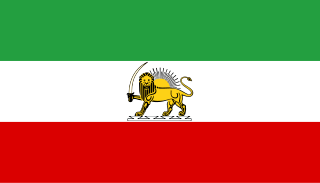
The Imperial State of Iran, also known as the Imperial State of Persia, was the official name of the Iranian state under the rule of the Pahlavi dynasty.
The 5th Mechanised Corps was a mechanised corps of the Red Army, formed on three occasions. It was first formed in 1934 and was converted into the 15th Tank Corps in 1938. It was reformed in the Far East in 1940 and moved west before the German invasion of the Soviet Union. It fought in the First Battle of Smolensk, losing large numbers of tanks in the Lepel counterattack. The corps was encircled in the Smolensk pocket and after breaking out was disbanded in late August 1941. Its third formation, from elements of the 22nd Tank Corps, occurred in September 1942. The corps fought in: Operation Little Saturn, Operation Gallop, the Second Battle of Smolensk, the Dnieper–Carpathian Offensive, and the Second Jassy–Kishinev Offensive. In September 1944, it became the 9th Guards Mechanised Corps.
The 48th Army was a field army of the Soviet Red Army, active from 1941 to 1945. The army was first formed in August 1941 and fought in the Leningrad Strategic Defensive Operation. The army suffered heavy losses and was disbanded in early September. Its remnants were moved to the 54th Army. Reformed in April 1942 on the Bryansk Front, the army fought in the Maloarkhangelsk Offensive in the winter of 1943. It was sent to the Central Front in March and defended the northern face of the Kursk Bulge. During the summer, it fought in Operation Kutuzov and the Chernigov-Pripyat Offensive. From November, the army fought in the Gomel-Rechitsa Offensive. The army fought in Operation Bagration from June 1944. During the offensive, the army captured Zhlobin and Bobruisk and was on the Narew by early September. During early 1945, the army fought in the East Prussian Offensive and ended the war in East Prussia during May. The army was transferred to Poland in July 1945 and its headquarters was used to form the Kazan Military District in September.
The 53rd Army was a field army of the Soviet Union's Red Army which was formed in August 1941, disbanded in December 1941, and reformed in May 1942. It fought throughout World War II before again being disbanded after the war in October 1945. The army was first formed for the Anglo-Soviet invasion of Iran and was disbanded there in December 1941. The army reformed in May 1942. It fought in the Demyansk Pocket, the Battle of Kursk, the Battle of Belgorod, the Battle of the Dnieper, the Battle of the Korsun–Cherkassy Pocket, the Uman–Botoșani Offensive, the Second Jassy–Kishinev Offensive, the Battle of Debrecen, the Budapest Offensive, and the Prague Offensive. At the end of the war in Europe it was moved to the Far East and fought in the Soviet invasion of Manchuria. The army was disbanded in October 1945.
The 351st Rifle Division first formed in September 1941, as a standard Red Army rifle division, at Stalingrad. It was assigned to the newly formed 57th Army in the same area shortly after forming, and remained in that Army for the duration of its existence. It helped to carve out the bridgehead north of Rostov known as the Izium Salient, but was encircled and destroyed during the Second Battle of Kharkov. A second 351st began forming in July 1942 in the North Caucasus, and went into combat in October, liberating the town of Alagir in January 1943. During the rest of that year and on into 1944 the division participated in the liberation of Ukraine under several Corps and Army headquarters and under command of a bewildering series of divisional commanders until Maj. Gen. I. F. Dudarev took command in April 1944, and held the post for just over a year. During its second formation the division compiled an enviable record of service and was recognized with several unit decorations and honors, but was disbanded shortly after the end of hostilities in Europe.
The 391st Rifle Division was raised in 1941 as an infantry division of the Red Army, and served for the duration of the Great Patriotic War in that role. It began forming in August 1941, in the Central Asian Military District. It was first assigned to Southwestern Front but on its arrival it was seen to be far from combat-ready and so was moved north to the Moscow area for further training. It was finally assigned to the 3rd Shock Army in Kalinin Front and took part in the battle for the Kholm Pocket. Following this the division was moved to 1st Shock Army and took part in the dismal fighting for the Demyansk salient until it was finally evacuated by the German forces in March, 1943. The division moved on into the gradual advance across the Baltic states through 1943 and 1944, winning a battle honor along the way, until February, 1945, when it was transferred with its 93rd Rifle Corps to 1st Ukrainian Front as part of 59th Army. In the last weeks of the war the 391st was awarded the Order of the Red Banner for its service in Upper Silesia, and ended the war advancing on Prague, but despite its distinguished record it was selected as one of the many divisions to be disbanded during the summer of 1945.












